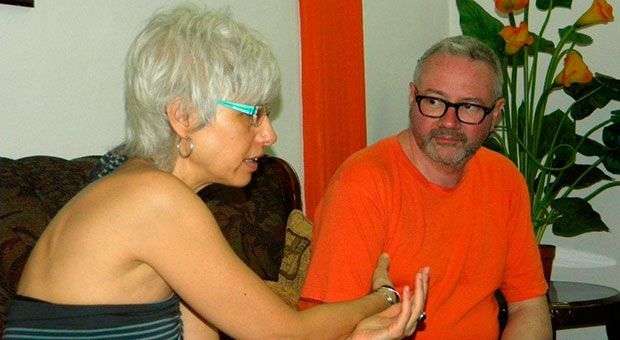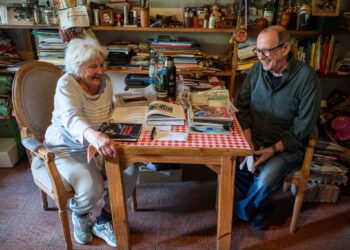For the third year in a row, a program of US documentaries under the name Closing Distances/Cerrando Distancias tours around Cuba. The event, organized by Alexandra Halkin, director of the Americas Media Initiative (AMI), non profit organization working with Cuban filmmakers, will take place until this Monday 14. As new, this year’s edition brings Simon Kilmurry, executive producer of the several times awarded television series POV (Point of View) by PBS, who, since his arrival in Cuba, has presented and debated on several Latin American movies that have been produced after his series, as for instance, Volver a la anormalidad, on which he debated with the public in Havana.
The tour started on the last day of ICAIC’s 2014 Young Sample (ICAIC: Cuban Film Institute by its acronym in Spanish) and included a trip to the Isle of Youth and Pinar del Rio province, where they are right now to continue interacting with spectators. On the spring of 2012, AMI launched the tour of US documentaries with the Museum of Modern Art (MoMa) of New York andthat was the first time this institution presented an official program in Cuba. Ever since, Closing Distances tours have screened six US documentaries, interacting with the Cuban audience in Cienfuegos, Camaguey, Holguin, Bayamo, Guantanamo, Baracoa, Sierra Maestra and Havana. AMI is the single US organization that has been granted a permit to screen US documentaries in Cuban provinces.
POV has been avant-garde in terms of reach, by using non fiction media to build new histories that dialogue on the most pressing social issues of contemporariness. Produced by American Documentary, Inc. and initiating its 27 season in PBS this year, POV is the platform for longest independent documentaries in the US television, broadcasting movies from all over the world. Since its creation, it has displayed about 400 films, many of which have received important awards.
OnCuba talked with Alexandra and Kilmurry, who have debated on their experiences at the International School of Cinema and Television (EICTV by its acronym in Spanish) of San Antonio de los Baños and at the University of Havana, to know more about this cultural initiative that aims at bringing closer these two nations.
How did Closing distances emerge?
Alexandra Halkin: It is a Project by my association Americas Media and this is the third tour, which has a lot to do with its name because its purpose is to close the existing gap between the Cuban and the US peoples, it is some sort of bridge we want to create through the cinema. On this occasion, we invited the POV program and we bring this documentary Volviendo a la anormalidad, which will be presented in its program for the current year during the summer. We show this material which is different from what people know to dialogue and for the people in Cuba to seeother realities in the US, because there is no knowledge on the US reality.
The idea of this Project emerged from an experience I had in Sierra Maestra Mountains a few years ago, when I went there to exchange with professionals from the television in the mountains. I am a filmmaker, a documentary producer and there I realized of the lack of information of Cubans on my country, that’s why I came up with the idea of bringing them filmsdifferent from what they are used to see, that are far away from stereotypes so that they get to know the truth, the same thing I do with Cuban productions.
What makes POV stand out from the broad US audiovisual production?
Simon Kilmurry: Every film we screen is produced independently and we focus on the why of causes and consequences of daily phenomena. We explore issues such as migration, human rights; we give voice to topics silenced by the media. We research and go deep into a subject; we leave nothing in the surface unlike many. We give a face and a body to subjects that can be abstract. It is not the sameto talk about migration when you have nothing to do with it than let it be told by its main characters; we offer that chancein contrast with the traditional governmental speech. The fact that we display our materials all over the world gives the audience the chance to explore diverse themes from diverse perspectives.
What’s the opinion on the Cuban cinema in the United States?
S.K.: The Cuban cinema is diverse, mostly as to documentaries. I’m taking many proposals to my country to debate them with colleagues so that they know another perspective of Cuba, very different to what is exhibited about it by the US media. Most American citizens know nothing about Cuban or Latin American films. Perhaps some of them may have a vague memory of Cuban films from the 60’s and 70’s. Thanks to associations like Alexandra’s many people are getting an update on these productions. The speech on Cuba in the US is very political and it avoids common stories of regular people that have a lot to tell.
A.H.: There is an idea but that’s not enough. There is a Festival in New York which screens some Cuban films but that’s not enough if we take a look at the high quality and artistic richness of the documentaries produced in Cuba independently and with ICAIC. When we screen Cuban films there is always plenty of interest so we keep on with our project.
Hollywood poses a challenge for POV due to its hegemony, how do you assume the challenge of shooting behind the industry?
S.K.: Hollywood is in a dominant position in North American culture. POV is an alternative, we have seen that lately people are more interested in documentaries and the audience is looking for something else, it doesn’t settle for the same canons, the reiteration of styles and topics. We offer a different proposal. Independent filmmakers tackle subjects the mass media ignores, we offer a space where marginalized voices represented in minorities can express themselves, we are a space reserved for polemic debates, we see beyond the surface unlike Hollywood. The greatest challenges we are facing, beyond Hollywood, are financing and distribution. Despite having more spaces for screening our work and having more access to the new technologies than we used to have 15 years ago, the shooting process is still hard because it is easy to find new stories, but the hard thing to do is to tell them right.










